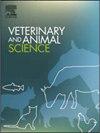A meta-analysis of genetic estimates for economically important traits in ducks
IF 1.9
Q2 AGRICULTURE, DAIRY & ANIMAL SCIENCE
引用次数: 0
Abstract
This study aimed to gather published genetic parameter estimates for economically important traits in ducks through a meta-analysis utilizing the random-effects model. The present study used a dataset on genetic parameters of various duck traits, including 275 genetic correlation estimates and 233 heritability estimates from 31 studies published between 1988 and 2024. The heritability estimates for growth traits were generally low to high and varied from 0.154 (for body weight gain) to 0.405 (for body weight at first egg), respectively. Results showed that heritability estimates for egg production and quality traits were generally low to moderate, ranging from 0.119 (for egg shell strength) to 0.340 (for egg weight). The heritability estimates for feeding traits were generally moderate to high and varied from 0.266 (for residual feed intake) to 0.624 (for meal feed intake), respectively. The results indicate that there was a high genetic correlation (0.827, P < 0.05) between feed intake and residual feed intake, but low to moderate genetic correlations (P < 0.05) were found between feed intake and feed conversion ratio (0.318). The results of the current meta-analysis supported the hypothesis that these duck traits exhibit additive genetic variation. Genetic selection schemes for ducks may thus potentially take advantage of the available additive genetic variation in these traits. Furthermore, in cases where accurate estimates for economically significant traits in duck populations across the globe are unavailable, the average genetic parameter estimates presented in this meta-analysis can be used in breeding plans.
对鸭子重要经济性状遗传估计值的荟萃分析
本研究旨在利用随机效应模型,通过荟萃分析收集已发表的鸭子重要经济性状的遗传参数估计值。本研究使用了一个关于鸭子各种性状遗传参数的数据集,包括 275 个遗传相关性估计值和 233 个遗传率估计值,这些数据来自 1988 年至 2024 年间发表的 31 项研究。生长性状的遗传力估计值一般由低到高,分别从 0.154(体重增加)到 0.405(初生蛋体重)不等。结果表明,产蛋量和蛋品质性状的遗传力估计值从低到高不等,从 0.119(蛋壳强度)到 0.340(蛋重)不等。采食量性状的遗传力估计值一般为中高,分别为 0.266(残余采食量)至 0.624(粉料采食量)。结果表明,采食量和残余采食量之间存在较高的遗传相关性(0.827,P < 0.05),但采食量和饲料转化率(0.318)之间存在中低遗传相关性(P < 0.05)。目前的荟萃分析结果支持了这些鸭子性状表现出加性遗传变异的假设。因此,鸭子的遗传选择方案有可能利用这些性状的可加遗传变异。此外,在无法获得全球鸭群中具有经济意义的性状的准确估计值的情况下,本荟萃分析中提出的平均遗传参数估计值可用于育种计划。
本文章由计算机程序翻译,如有差异,请以英文原文为准。
求助全文
约1分钟内获得全文
求助全文
来源期刊

Veterinary and Animal Science
Veterinary-Veterinary (all)
CiteScore
3.50
自引率
0.00%
发文量
43
审稿时长
47 days
 求助内容:
求助内容: 应助结果提醒方式:
应助结果提醒方式:


